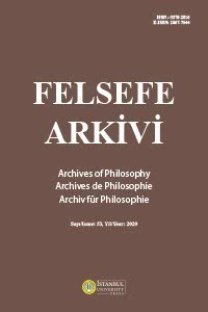250. Yılında Kant’ın Duyulur ve Anlaşılır Dünyanın Form ve İlkeleri Eseri Üstüne
Kant’ın Eleştiri Öncesi ve Eleştirel Felsefesi, Duyusallık, Anlayış, 1770 Tezi
On Kant’s Form and Principles of the Sensible and the Intelligible World on its 250th Anniversary
Kant’s Pre-Critical Philosophy Kant’s Critical Philosophy, Inaugural Dissertation, Sensibility, Intelligence,
___
- Allison, Henry E. Kant’s Transcendental Deduction An Analytical-Historical Commentary. Oxford: Oxford University Press, 2015.
- Beck, Lewis White. Essay on Kant and Hume. New Haven: Yale University Press, 1978.
- Beiser, Frederick C. “Kant’s Intellectual Development: 1746-1781”. Içinde The Cambridge Companion to Kant, editör Paul Guyer, 26–61. Cambridge: Cambridge University Press, 1992.
- Eckoff, William J. Kant’s Inaugural Dissertation of 1770. New York: Columbia College, 1894.
- Kant, Immanuel. “Briefwechsel 1747-1788”. Içinde Kant’s gesammelte Schriften Preußische Akademie der Wissenschaften, C. X, 1911.
- ———. “De Mundi Sensibilis atque Intelligibilis Forma et Principiis”. Içinde Kant’s Gesammelte Schriften Preußische Akademie der Wissenschaften, C. 2, 1926.
- ———. “Dissertation on the Form and Principles of the Sensible and Intelligible World”. Içinde Kant’s Inaugural Dissertation and Early Writings on Space, çeviren John Handyside, 35–85. Chicago : London: The Open Court Publishing Company, 1929.
- ———. “Kritik der reinen Vernunft”. Içinde Kant’s gesammelte Schriften Preußische Akademie der Wissenschaften, C. 3. Berlin: Georg Reimer, 1911.
- ———. “On the Form and Principles of the Sensible and the Intelligible World [Inaugural Dissertation]”. Içinde Theoretical Philosophy, 1755-1770, çeviren David Walford ve Ralf Meerbote, 373–416. New York: Cambridge University Press, 1992.
- ———. Philosophical Correspondence 1759-1799. Çeviren Arnulf Zweig. Cambridge: Cambridge University Press, 1999. Kuehn, Manfred. Kant: A Biography. New York: Cambridge University Press, 2001.
- Layvine, Alison. “Kant’s Early Metaphysics and the Origins of the Critical Philosophy”. Içinde North American Kant Society Studies in Philosophy, editör Manfred Kuehn ve Karl Ameriks, C. 3. California: Ridgeview Publishing Company, 1993.
- Schönfeld, Martin. The Philosophy of the Young Kant: The Precritical. Oxford: Oxford University Press, 2000.
- Walfrod, David. “General Introduction”. Içinde Immanuel Kant: Theoretical Philosophy, 1755–1770, çeviren David Walfrod ve Ralf Meerbote, xxxv–lxxiv. Cambridge: Cambridge University Press, 1992.
- Ward, James. A Study of Kant. Cambridge: Cambridge University Press, 1922.
- ISSN: 0378-2816
- Yayın Aralığı: 2
- Başlangıç: 1945
- Yayıncı: İstanbul Üniversitesi
250. Yılında Kant’ın Duyulur ve Anlaşılır Dünyanın Form ve İlkeleri Eseri Üstüne
Machiavelli’nin Gambiti: Devlet Aklı Doktrini’nin Kökenlerine İlişkin Bir Soruşturma
Sınır-Fenomen Olarak Rüyasız Uyku
John Rawls'un Adalet Düşüncesinin Oluşum Şartları Üzerine
Russell-Meinong Tartışması Üzerine
Cambridge Değişimi ve bir Zorunlu Soru: Bir Nesne Olmak Ne demektir?
